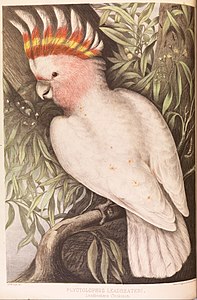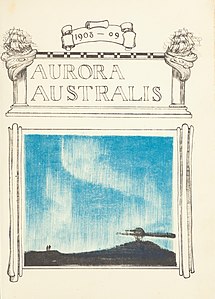
The National Gallery of Victoria, popularly known as the NGV, is an art museum in Melbourne, Victoria, Australia. Founded in 1861, it is Australia's oldest and most visited art museum.
The Melbourne Museum is a natural and cultural history museum located in the Carlton Gardens in Melbourne, Australia.

The Canadian Museum of Nature is a national natural history museum based in Canada's National Capital Region. The museum's exhibitions and public programs are housed in the Victoria Memorial Museum Building, a 18,910-square-metre structure (203,500 sq ft) in Ottawa, Ontario. The museum's administrative offices and scientific centres are housed at a separate location, the Natural Heritage Campus, in Gatineau, Quebec.

State Library Victoria (SLV) is the state library of Victoria, Australia. Located in Melbourne, it was established in 1854 as the Melbourne Public Library, making it Australia's oldest public library and one of the first free libraries in the world. It is also Australia's busiest public library and, as of 2023, the third busiest library globally.

Baron Sir Ferdinand Jacob Heinrich von Mueller, was a German-Australian physician, geographer, and most notably, a botanist. He was appointed government botanist for the then colony of Victoria, Australia by Governor Charles La Trobe in 1853, and later director of the Royal Botanic Gardens in Melbourne. He also founded the National Herbarium of Victoria. He named many Australian plants.

Sir Frederick McCoy, was an Irish palaeontologist, zoologist, and museum administrator, active in Australia. He is noted for founding the Botanic Garden of the University of Melbourne in 1856.

Johann Ludwig (Louis) Gerard Krefft, was an Australian artist, draughtsman, scientist, and natural historian who served as the curator of the Australian Museum for 13 years (1861–1874). He was one of Australia's first and most influential zoologists and palaeontologists.
Some of [Krefft's] observations on animals have not been surpassed and can no longer be equalled because of the spread of settlement.
Mr. Krefft was probably the first man who thoroughly studied the reptiles of Australia.

The South Australian Museum is a natural history museum and research institution in Adelaide, South Australia, founded in 1856 and owned by the Government of South Australia. It occupies a complex of buildings on North Terrace in the cultural precinct of the Adelaide Parklands. Plans are under way to move much of its Australian Aboriginal cultural collection, into a new National Gallery for Aboriginal Art and Cultures.
The Western Australian Museum is a statutory authority within the Culture and the Arts Portfolio, established under the Museum Act 1969.

Johann Wilhelm Theodor Ludwig von Blandowski, known as William Blandowski, was a German explorer, soldier, zoologist and mining engineer of Polish descent, famous for his exploration of the Murray and Darling Rivers in Australia.

The Royal Society of Victoria (RSV) is the oldest scientific society in Victoria, Australia.

The National Museum of Bosnia and Herzegovina is located in central Sarajevo, the capital of Bosnia and Herzegovina.

The Field Naturalists Club of Victoria (FNCV) is an Australian natural history and conservation organisation. The club is the oldest of its kind in Australia and is unique in having existed continuously since its foundation. Since its founding, the club has drawn its membership from the ranks of both amateur naturalists and professional scientists. This dual stream of members has continued into the 21st century, in which the club is well known for not only its scientific research output, but also numerous ongoing citizen science projects.

The San Diego Natural History Museum is a museum in Balboa Park in San Diego, California. It was founded in 1874 as the San Diego Society of Natural History. It is the second oldest scientific institution west of the Mississippi and the oldest in Southern California. The present location of the museum was dedicated on January 14, 1933. A major addition to the museum was dedicated in April 2001, doubling exhibit space.
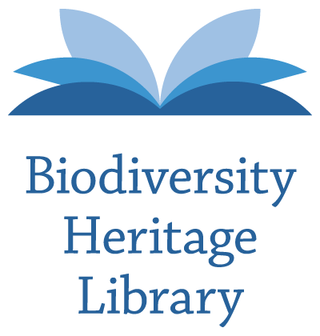
The Biodiversity Heritage Library (BHL) is the world’s largest open-access digital library for biodiversity literature and archives. BHL operates as a worldwide consortium of natural history, botanical, research, and national libraries working together to address this challenge by digitizing the natural history literature held in their collections and making it freely available for open access as part of a global "biodiversity community". The BHL consortium works with the international taxonomic community, publishers, bioinformaticians, and information technology professionals to develop tools and services to facilitate greater access, interoperability, and reuse of content and data. BHL provides a range of services, data exports, and APIs to allow users to download content, harvest source data files, and reuse materials for research purposes. Through taxonomic intelligence tools developed by Global Names Architecture, BHL indexes the taxonomic names throughout the collection, allowing researchers to locate publications about specific taxa. In partnership with the Internet Archive and through local digitization efforts, BHL's portal provides free access to hundreds of thousands of volumes, comprising over 59 million pages, from the 15th–21st centuries.

The Blandowski expedition was an Australian scientific expedition that took place between 1856 and 1857 to study the natural history of the region and acquire specimens for the Victorian Museum. The expedition departed from Melbourne on route to Mondellimin the area of the junction of the Darling and Murray Rivers in north-western Victoria following the Murray to Goolwa in South Australia.
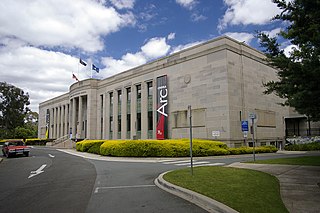
The Australian Institute of Anatomy was a natural history museum and medical research institute that was founded in 1931 and disbanded in 1985. The institute's heritage-listed building, located in Acton, Canberra, in the Australian Capital Territory, Australia, has been occupied by the National Film and Sound Archive (NFSA) since October 1984. The building was added to the Commonwealth Heritage List on 22 June 2004.
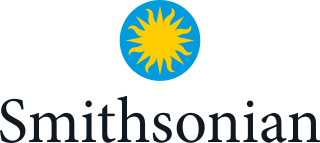
Smithsonian Libraries and Archives is an institutional archives and library system comprising 21 branch libraries serving the various Smithsonian Institution museums and research centers. The Libraries and Archives serve Smithsonian Institution staff as well as the scholarly community and general public with information and reference support. Its collections number nearly 3 million volumes including 50,000 rare books and manuscripts.

The Natural History Museum of Denmark is a natural history museum located in Copenhagen, Denmark. It is affiliated with the University of Copenhagen

Arthur Bartholomew was an English-born Australian engraver, lithographer and natural history illustrator. He was the son of Thomas Bartholomew, a builder, and Charlotte Wright.









